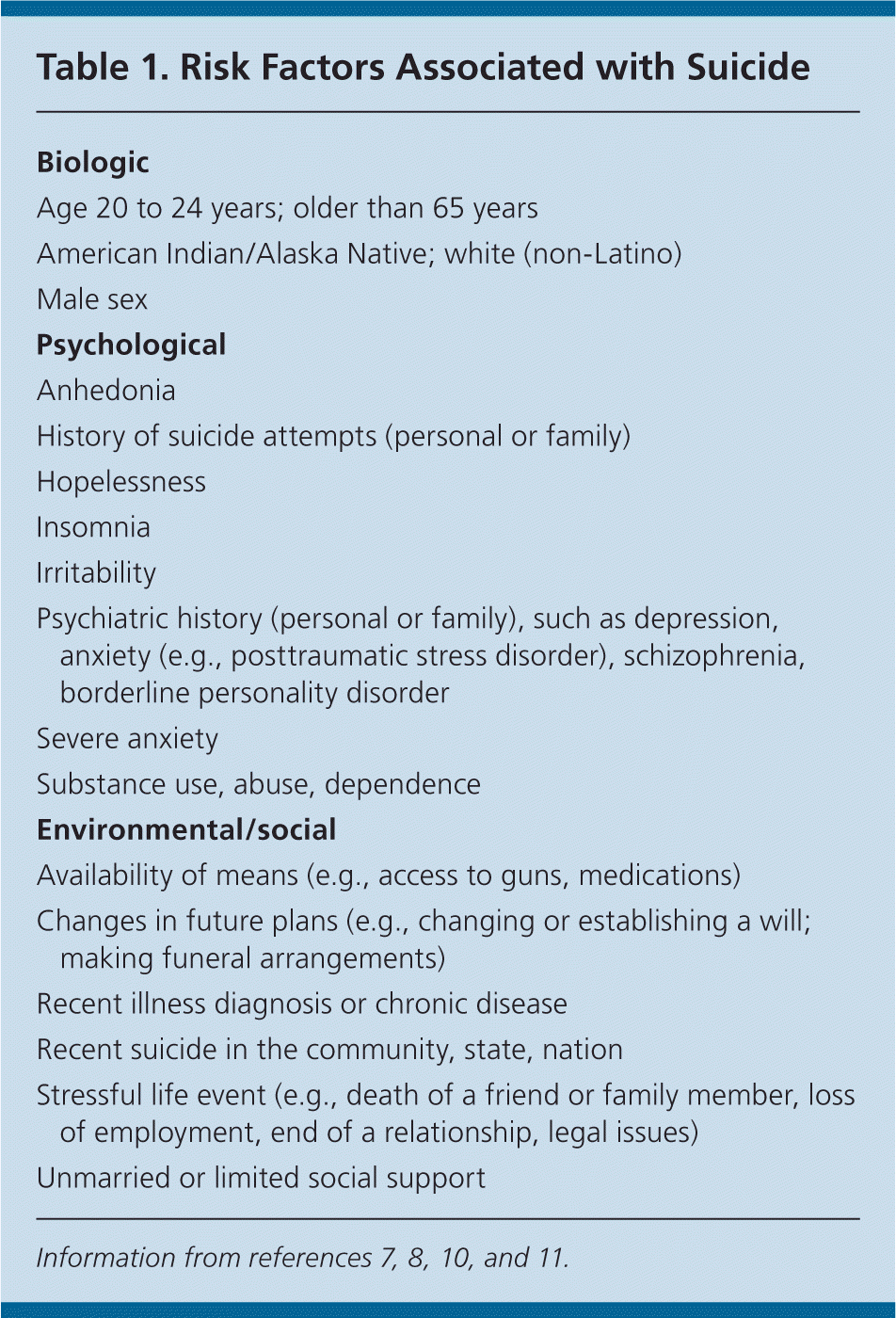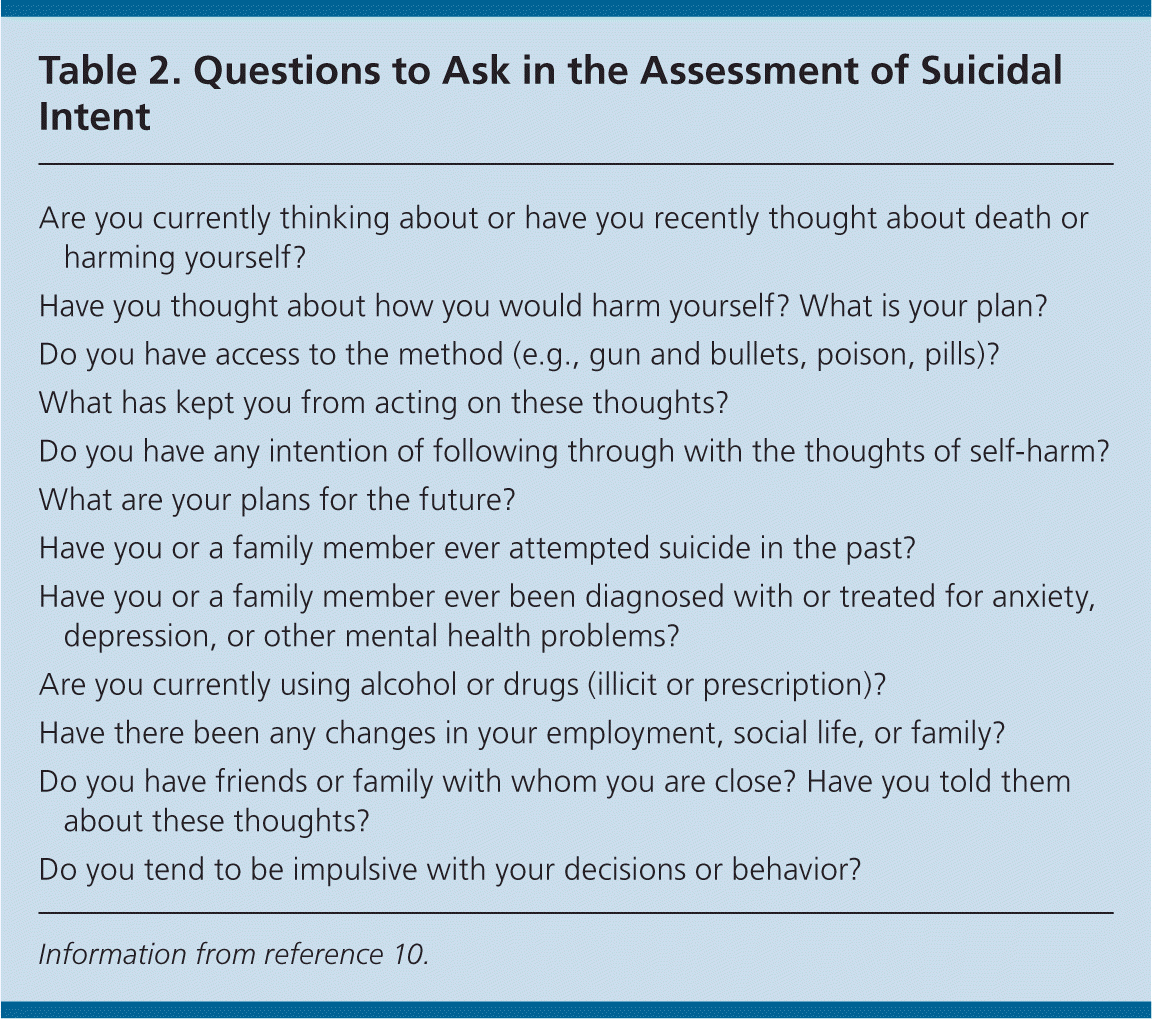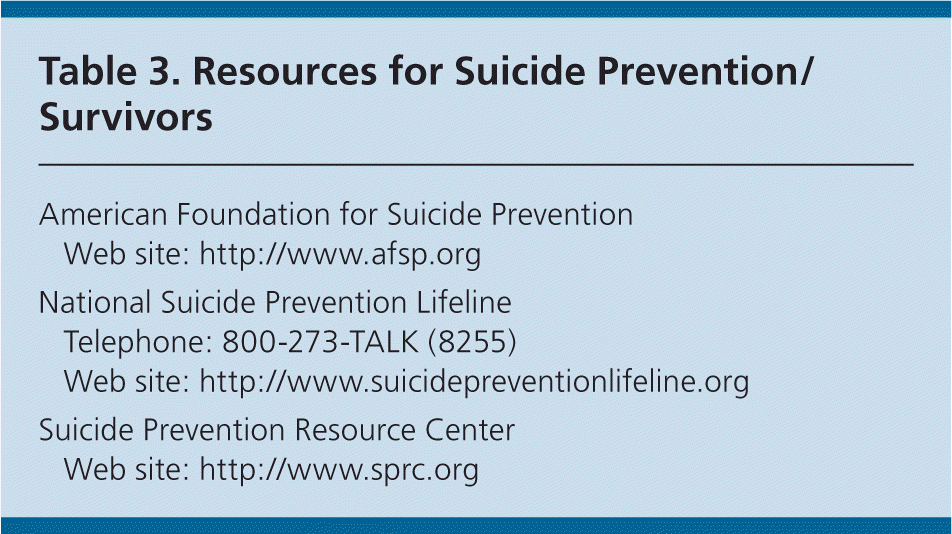
Am Fam Physician. 2012;85(6):602-605
Patient information: See related handout on help for people who are thinking about suicide, written by the authors of this article.
Author disclosure: No relevant financial affiliations to disclose.
Evaluation and treatment of a suicidal patient are challenging tasks for the physician. Because no validated predictive tools exist, clinical judgment guides the decision-making process. Although there is insufficient evidence to support routine screening, evidence shows that asking high-risk patients about suicidal intent leads to better outcomes and does not increase the risk of suicide. Important elements of the history that permit evaluation of the seriousness of suicidal ideation include the intent, plan, and means; the availability of social support; previous suicide attempts; and the presence of comorbid psychiatric illness or substance abuse. After intent has been established, inpatient and outpatient management should include ensuring patient safety and medical stabilization; activating support networks; and initiating therapy for psychiatric diseases. Care plans for patients with chronic suicidal ideation include these same steps, as well as referral for specialty care. In the event of a completed suicide, physicians should provide support for family members who may be experiencing grief complicated by guilt, while also activating their own support networks and risk management systems.
Suicide accounts for more than 34,000 deaths per year in the United States, with completed and attempted suicides leading to 472,000 emergency department visits.1,2 It is the fourth leading cause of death in adults 18 to 65 years of age and the 11th leading cause of mortality among adults overall. In children, suicide is the fifth leading cause of death.3 Among completed suicides, firearms are the most common means (50 to 60 percent), followed by suffocation and poisoning, which includes medication overdose.1
| Clinical recommendation | Evidence rating | References |
|---|---|---|
| Direct inquiry concerning suicidal ideation in patients with risk factors is associated with more effective treatment and management. | C | 7, 8 |
| Screening for depression, anxiety, and alcohol use helps to determine symptom severity in a patient with possible suicidal ideation. | C | 12 |
| Use of suicide prevention contracts should generally be avoided. | C | 13 |
| Treatment of suicidal ideation should include medications and psychological interventions. | C | 14 |
Epidemiology and Risk Factors
Women are three to four times more likely than men to attempt suicide; however, men are four times more likely to complete an attempt. Men are more likely to use violent means, including firearms and hanging, whereas women use more passive means such as poisoning.4
One of the most important risk factors for suicide attempt and completion is comorbid psychiatric illness, particularly in patients with a prior attempt. This includes patients with substance abuse disorders, depression, psychotic disease, and posttraumatic stress disorder. Although persons with depressive disorders have the highest risk, substance abuse is also a significant risk factor because it may be used to mask other illnesses or to provide the decreased inhibition necessary to attempt suicide. In patients with psychotic disorders, those who have schizophrenia with hallucinations instructing them to harm themselves (i.e., command hallucinations) are at highest risk, and those with frequent and severe exacerbations, good insight, and high premorbid functioning are also at increased risk.4
Evaluation
It is rare for suicidal ideation to be the chief problem in the outpatient setting. More often, patients have symptoms that may ultimately be related to suicidal ideation. For example, a patient may have gastrointestinal upset related to increased stress or depression. On further assessment, additional risk factors for suicide may be present.
Evidence shows that inquiring about suicide does not increase suicidal ideation or attempts. In a recent randomized trial of 443 adult patients with depression, there was no statistical difference in suicidal ideation or behavior between participants assigned to early questioning about suicidal thoughts and those assigned to delayed questioning.6
Direct inquiry concerning suicidal ideation in patients with risk factors is associated with more effective treatment and management7,8 because it allows the physician to gain necessary information while potentially alleviating patient anxiety.9 Assessment of the seriousness of suicidal ideation should include additional known risk factors (Tables 17,8,10,11 and 210 ). For example, 90 percent of persons who complete suicide have a concomitant mental or addictive disorder.11

| Biologic |
| Age 20 to 24 years; older than 65 years |
| American Indian/Alaska Native; white (non-Latino) |
| Male sex |
| Psychological |
| Anhedonia |
| History of suicide attempts (personal or family) |
| Hopelessness |
| Insomnia |
| Irritability |
| Psychiatric history (personal or family), such as depression, anxiety (e.g., posttraumatic stress disorder), schizophrenia, borderline personality disorder |
| Severe anxiety |
| Substance use, abuse, dependence |
| Environmental/social |
| Availability of means (e.g., access to guns, medications) |
| Changes in future plans (e.g., changing or establishing a will; making funeral arrangements) |
| Recent illness diagnosis or chronic disease |
| Recent suicide in the community, state, nation |
| Stressful life event (e.g., death of a friend or family member, loss of employment, end of a relationship, legal issues) |
| Unmarried or limited social support |

| Are you currently thinking about or have you recently thought about death or harming yourself? |
| Have you thought about how you would harm yourself? What is your plan? |
| Do you have access to the method (e.g., gun and bullets, poison, pills)? |
| What has kept you from acting on these thoughts? |
| Do you have any intention of following through with the thoughts of self-harm? |
| What are your plans for the future? |
| Have you or a family member ever attempted suicide in the past? |
| Have you or a family member ever been diagnosed with or treated for anxiety, depression, or other mental health problems? |
| Are you currently using alcohol or drugs (illicit or prescription)? |
| Have there been any changes in your employment, social life, or family? |
| Do you have friends or family with whom you are close? Have you told them about these thoughts? |
| Do you tend to be impulsive with your decisions or behavior? |
Additionally, behavioral observations may provide information about the severity of symptoms and level of risk. Patients who present with a disheveled appearance or poor hygiene, or who seem withdrawn or agitated, along with recent or current suicidal ideation may be at increased risk of suicide attempts. A mental status examination can be used to assess patient functioning and inform the course of treatment. Although the U.S. Preventive Services Task Force found insufficient evidence to recommend for or against routine screening for suicide risk in a primary care setting, screening instruments for depression, anxiety, and alcohol use further substantiate the severity of symptoms.12 Because no validated predictive tools exist, clinical judgment guides the decision-making process.
Short-term Management
After necessary medical stabilization in the event of a suicide attempt, an environment that provides adequate patient protection must be selected. Patients who have suicidal ideation, but no plan or means in place, and who have good social support may be treated as outpatients. With patient permission, close family or friends should be involved to ensure patient safety and adherence.7 Suicide prevention contracts have not been shown to reduce suicide attempts and should generally be avoided.13
Inpatient admission should be offered for patients with specific plans for suicide who have the means to complete their plan. In many states, involuntary admission is an option. Physicians should be aware of the statutes in their jurisdictions.4 Table 3 lists resources where further information on state and local statutes may be found. When in doubt regarding the need for admission, inpatient care is the more prudent option. However, if a patient is referred for admission, but not placed in the hospital, he or she may experience additional stress and increased feelings of helplessness.

| American Foundation for Suicide Prevention | |
| Web site: http://www.afsp.org | |
| National Suicide Prevention Lifeline | |
| Telephone: 800-273-TALK (8255) | |
| Web site: http://www.suicidepreventionlifeline.org | |
| Suicide Prevention Resource Center | |
| Web site: http://www.sprc.org | |
Regardless of the treatment setting, ensuring patient safety is a primary concern. Caregivers should remove weapons and medications that could be used for deliberate self-harm and should monitor the patient frequently. During inpatient admissions, patients may need to stay in a locked unit where they do not have access to stairwells, light fixtures, and other installations that could be used for hanging. Frequent contact with staff can provide early identification of and stabilization after more suicide attempts.4
Treatment of underlying psychiatric or substance abuse disorders should be initiated as early as possible and should be tailored to individual patients. It should generally consist of some form of pharmacotherapy plus psychological evaluation and treatment.14
For suicidal patients with mood disorders, lithium has been proven to decrease suicide attempts and all-cause mortality.15 In those with underlying psychotic disorders, olanzapine (Zyprexa) and clozapine (Clozaril) have been shown to provide benefit, although other antipsychotics may also be beneficial.16 The use of clozapine is restricted because of the potential for agranulocytosis.16 There are also concerns about the use of selective serotonin reuptake inhibitors (SSRIs) and newer antidepressant medications. A U.S. Food and Drug Administration boxed warning has been issued because of increased risk of suicidality in adolescents and young adults in the early months after starting SSRI therapy.17 Further systematic reviews and meta-analyses have shown that, although there is an increased risk of suicide attempts in patients taking SSRIs, the completion rate is no different than with older drugs or placebos.18,19 SSRIs may still be used to treat mood disorders in these high-risk populations; however, they should be accompanied by patient education and additional monitoring (e.g., scheduled visits, telephone calls).20
Long-term Management
After initial stabilization and improvement of suicidal ideation, the patient remains at increased risk. Patients who attempt suicide have a risk of death in the following year 100 times greater than that of the general population.21 Therefore, it is important to involve the patient's social support system in assisting with management. In addition to frequent contact with the primary care physician, the patient should have access to behavioral health specialists, as well as community programs such as Alcoholics Anonymous or Narcotics Anonymous if substance abuse or dependence is involved.22
For patients with personality disorders, particularly borderline, histrionic, and narcissistic disorders, suicidal gestures and intent may become common and chronic in nature. The physician must be vigilant in taking each threat seriously, because gestures may become lethal. An expert consensus practice guideline suggests that physicians should assess for suicide risk level and coping resources, and help patients identify problem-solving techniques. If the patient remains at a high risk of self-harm, referrals to emergency services and specialty care are recommended.23
Coping with a Completed Suicide
A completed suicide puts stress on the patient's loved ones and physician. These stressors may include personal and legal ramifications. Bereavement after suicide is similar to that after other causes of death; however, survivors are more likely to feel shame and to blame themselves for the loss.24 The physician should be prepared to support the family members through this difficult transition. Survivors have reported that their needs vary from formal counseling with professionals to more informal social support from friends, family, and support groups.25 Support groups may be found through the resources listed in Table 3.
In situations in which the physician must face an angry family, prudent steps include careful documentation; notification of hospital, managed care, and malpractice risk management teams; and taking care to compassionately give condolences to the family without assigning blame.26
Some physicians who have had a patient commit suicide report feelings of guilt and personal responsibility, as well as descent into a mood disorder. This is particularly common among those who think they missed warning signs or could have done more to protect their patient.27 If physicians develop suicidal ideations, they may be at increased risk of a suicide attempt because of their advanced medical knowledge and access to lethal means. To cope with this stress, physicians should have access to social support and medical and psychological care.28
Data Sources: A PubMed search was completed using the key terms suicide, suicide risk factors, suicide prevention, suicide treatment, and suicide interventions. Also searched were Essential Evidence Plus, the Cochrane database, National Guidelines Clearinghouse, U.S. Preventive Services Task Force, and UpToDate. Search Date: January 7, 2011.
